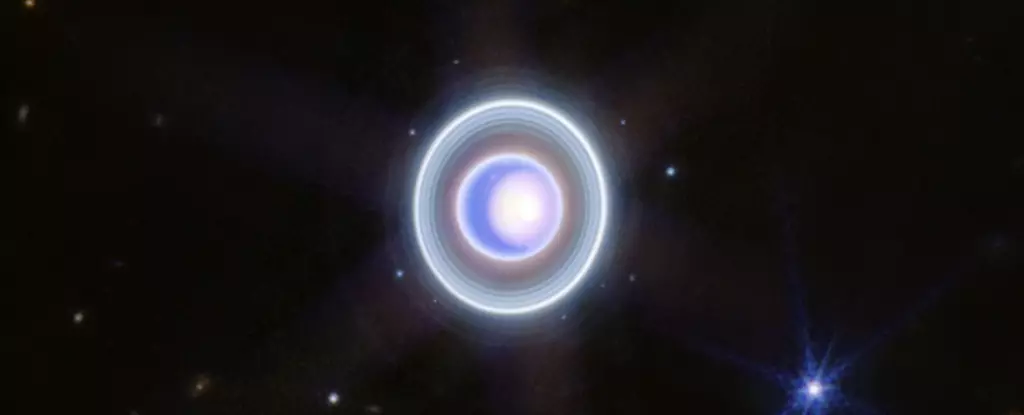Understanding the outer planets of the Solar System has long been challenging, and Uranus stands out with its unique characteristics and puzzling features. For decades, our perceptions of Uranus were largely shaped by the Voyager 2 mission, a remarkable feat of space exploration that flew by the planet in 1986. However, recent analyses suggest that the observations made during this historic event may not represent the planet’s normal state, particularly regarding its unusual magnetic field. As researchers delve deeper into solar data, we’re beginning to realize that our understanding of Uranus might require significant adjustments.
Voyager 2: A Historical Context
Voyager 2 remains a critical milestone in planetary science, providing the first close-up images and detailed data on Uranus and its moons. The information gathered included dimensions of its magnetic field, which appeared decidedly unconventional compared to other gas giants in the Solar System, such as Jupiter, Saturn, and Neptune. The magnetic field was found to be misaligned and eccentric, prompting scientists to postulate about Uranus’s unique interior structure. This anomalous magnetic behavior led to hypotheses about the driving forces behind its magnetosphere, raising questions that have tantalized researchers for years.
Yet, this prevailing narrative may not be entirely accurate. Jamie Jasinski, a space plasma physicist at NASA’s Jet Propulsion Laboratory, has recently pioneered a reexamination of the conditions surrounding Voyager 2’s flyby. His findings indicate that the apparent chaos in Uranus’s magnetic field was likely a temporary phenomenon, shaped by solar activity at the time of the mission.
Upon reviewing solar wind data, Jasinski observed that the solar storm preceding the Voyager 2 encounter had significantly influenced the behavior of Uranus’s magnetosphere. It turned out that the solar wind’s dynamic pressure surged dramatically just before the flyby, compressing Uranus’s magnetic field to a striking 20% of its typical volume. This discovery revealed that the circumstances during the Voyager 2 flyby were not reflective of Uranus’s usual magnetospheric state, but rather a rare and extreme event driven by heightened solar activity.
This revelation challenges the long-held assumption that the peculiarities observed in Uranus’s magnetosphere are generally characteristic of the planet. Instead, it emphasizes the dynamic nature of celestial phenomena, highlighting that solar weather plays a crucial role in the characteristics we observe in distant planets. Jasinski’s analysis reframes our understanding of Uranus, asserting that the planet’s magnetic field might be more earthly—similar to those of other gas giants—were it not for the interference from solar dynamics at that particular moment.
The implications of this newfound understanding are profound. If Uranus does possess a magnetic field that is more akin to its gas giant cousins, then the unique geological and atmospheric conditions posited by scientists might require reevaluation. Long-held beliefs about Uranus’s internal composition and the processes that govern its magnetosphere may soon be in need of revisions.
Furthermore, this analysis calls attention to the limitations of a single observational event in understanding complex systems like Uranus. Jasinski’s insights reveal how explorations can be misleading if not contextualized within their environmental state. For Earth-bound scientists, the need for a dedicated mission aimed at the study of Uranus and its moons has never been clearer. Comprehensive observations are essential not only to confirm these new findings but also to piece together the larger dynamics of this intriguing planet.
Astrobiologists and planetary scientists have continuously advocated for more missions to Uranus and its enigmatic moons. Understanding the implications posed by solar activity on the planet’s magnetosphere could yield insights into the broader dynamics of planetary systems. Moreover, there is potential for new data to uncover the interactions between Uranus and its numerous moons, many of which could hold their own geological secrets.
Revisiting the Voyager 2 data with a fresh perspective illuminates the dynamic nature of Uranus, emphasizing that our knowledge of the Solar System is continuously evolving. This reanalysis by Jasinski’s team not only sheds light on Uranus’s peculiar magnetic field but also serves as a reminder of the complexities inherent in space exploration. The enigmatic planet offers a tantalizing vista for future research, beckoning astronomers and physicists to untangle the mysteries yet to be discovered in its swirling clouds and vast systems of moons.


Leave a Reply